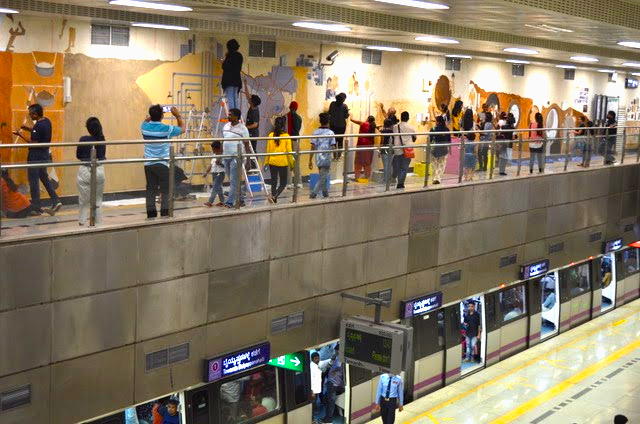Art in Transit

Art in Transit is a truly inspired project that combines art, community engagement, awareness building through storytelling and recording traditional cultural practices. The project involved creating a large mural on one of the walls of the Cubbon Park Metro station. This mural depicts the water story of Bengaluru, including the story of the well diggers. The mural was painted using mud from the 65 recharge wells being dug in Cubbon Park. During a two-week period in the latter half of 2019, passing commuters could participate in the painting of the mural under the guidance of Srishti School of Art and Design, who executed the project in collaboration with Biome Environmental Trust. The funding for this project was provided by the Bangalore Sustainability Forum.
The project was covered by the media – by the New Indian Express and the Times of India among others. Srishti also made a film on it.
Srishti has this to say about the project:
‘The mural at Cubbon Park Metro Station is the first pilot to understand the potential of making water-stories visible across the Bangalore Metro lines. The intention that Srishti embarked on, is to tell place-specific water stories particular to the context (history, geography, ecology, economy) of the area in and around the station. By telling these stories at the station, the intention is to build public knowledge and participation around water in the city. We are currently working on ideas for Chikpete and see the potential for this to continue at other Metro Stations like stories around the Vrishabhavathi at Vijaynagar. There were multiple stakeholders in this process – the well-diggers who spoke with us, gave us the mud and invited us to their village to tell their stories; students – up to 40 of them, who developed the visual material for the mural; poets who worked with the content and developed poems to communicate about water and well-digging practice; commuters – close to 300 commuters participated in the community paint days and stopped to ask questions and engage in conversations about the mural and other partners and collaborators who came forward to paint the mural and be a part of the process. Just in terms of sheer direct participants, we have engaged with close to 450 people during the process of this mural. This does not count the number of commuters who have approached us to ask about the mural, or those who have stopped in front of it to take selfies. The mural has the potential to be a site for water events, like conversations, talks, opportunities for awareness and the building of various water narratives to shift and infuse water awareness into public consciousness.’
Here are some images of the completed mural:










